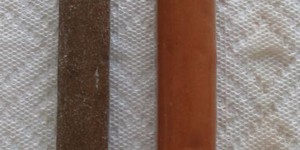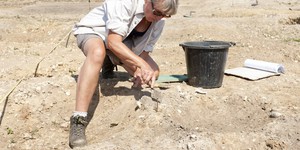Log In
Summary
Active Time
45 minutes to 1 hour
Total Project Time
3 or more days
Key Concepts
mummification, desiccation, decomposition, Egyptology, natron salts
Credits
Teisha Rowland, PhD, Science Buddies
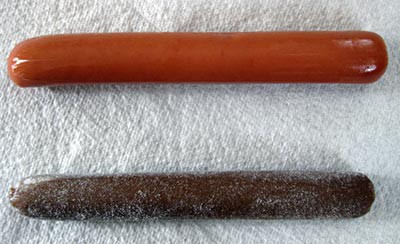
Introduction
Have you ever seen or heard of the movies "The Mummy" or "The Mummy Returns"? Mummies have often played a part in nightmares for Western cultures, but in ancient Egypt, mummification was a serious religious ritual thought to be necessary for a person to enjoy the afterlife. In this activity, you will learn about the science behind the process of mummification by mummifying a hot dog.
This activity is not recommended for use as a science fair project. Good science fair projects have a stronger focus on controlling variables, taking accurate measurements, and analyzing data. To find a science fair project that is just right for you, browse our library of over 1,200 Science Fair Project Ideas or use the Topic Selection Wizard to get a personalized project recommendation.
Materials
- Ruler
- Scrap piece of paper and pen or pencil
- Piece of string or yarn
- Paper towels
- Airtight plastic storage box with lid. Box must be at least 3 inches deep and longer and wider than the hot dog.
- Meat hot dog
- Baking soda, approximately 3 pounds from unopened packages. You will need enough to thoroughly surround and cover the hot dog in the box. Baking soda is also known as sodium bicarbonate.
- Optional: Disposable gloves
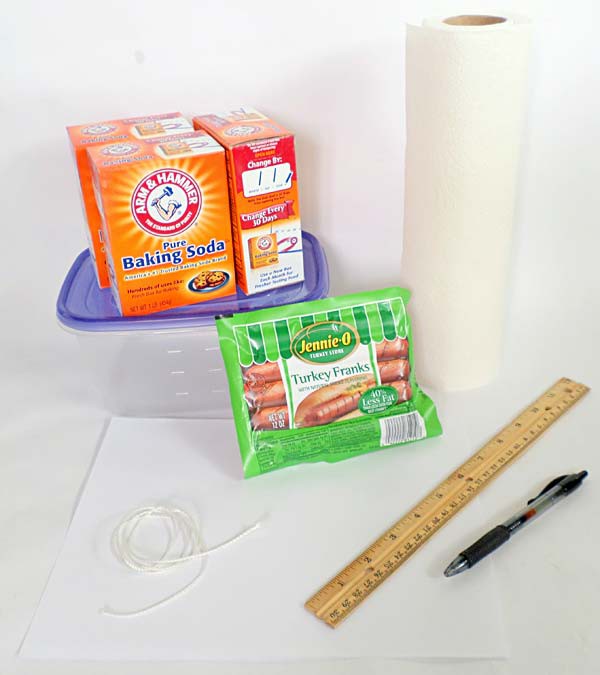 Image Credit: Teisha Rowland, Science Buddies / Science Buddies
Image Credit: Teisha Rowland, Science Buddies / Science Buddies
Prep Work
- If you do not wear gloves while handling the hot dog, be sure to thoroughly wash your hands after handling it.
Instructions
- Place the hot dog on top of a paper towel on a counter or other hard surface. If you want to, you can wear disposable gloves while handling the hot dog.
- Observe the hot dog.How does it look and smell?
- Measure the length of the hot dog and its circumference. (Measure its circumference by wrapping the string around the hot dog and then laying that length of the string up next to the ruler.) Write these measurements down.
- Put at least 1 inch of baking soda (from a new, unopened box) in the bottom of the storage box. Lay the hot dog flat on top of the baking soda. Cover the hot dog with at least 1 more inch of baking soda, making sure the hot dog has baking soda along its sides and is completely covered on top with baking soda.
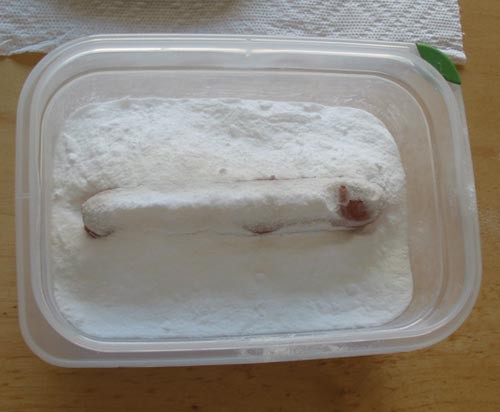 Image Credit: Michelle Maranowski / Permission granted
Image Credit: Michelle Maranowski / Permission granted
- Seal the box with its lid and put it in an indoor shady location, away from heating and cooling vents, where it will not be disturbed. It should be undisturbed for one week.
- After one week, check on the hot dog. You may use gloves to handle it, or wash your hands after handling it. Gently tap and dust all of the baking soda off of the hot dog and into a trash can.How does the hot dog look and smell now? How is it different from how it was on the first day?
- Place the hot dog on a paper towel and measure the length and circumference of the hot dog. Write these measurements down.Has the length or circumference changed?
Cleanup
Do not eat the mummified hot dog! It can be disposed of in the trash.
What Happened?
Baking soda is a desiccant, which is a substance that dries out things next to it. It does this by absorbing moisture from its surrounding environment. The baking soda should have absorbed the moisture from the hot dog, desiccating it, or drying it out. (Fresh baking soda is needed because older baking soda will not be as effective, having already absorbed moisture from its surrounding environment.) As the hot dog lost moisture, it changed in color, smelled bad, and shrank. For different brands of hot dog you may see slightly different measurements, but for one of our trials we saw the hot dog become about 4% shorter and 25% smaller in circumference after one week.Digging Deeper
A mummy is a corpse whose skin and flesh have been preserved by chemicals or by exposure to the elements of weather. It is thought that the ancient Egyptians believed that preserving the body was important for a person's afterlife. The oldest evidence of Egyptians performing mummification dates to about 3500 B.C. (although older purposefully mummified remains have been found elsewhere, such as ones dating to about 5050 B.C. in Chile). There were several steps to the Egyptian ritual of mummification that were important for preserving a body. After thoroughly washing the body in the waters of the Nile River, an embalmer would remove several internal organs from the body. This was important because internal organs are some of the first parts of the body to decompose. The body would then be stuffed and covered with natron to desiccate it. Natron is a naturally found salt mixture of desiccants that includes baking soda (sodium bicarbonate). Once desiccated, the body was rubbed with perfumed oils and then carefully wrapped with linen bandages. The remains were then placed inside of a sarcophagus, inside a tomb. In this activity, you get to play embalmer and mummify a hot dog using baking soda.Ask an Expert
Curious about the science? Post your question for our scientists.
For Further Exploration
- Try this activity with different varieties of hot dogs. Do chicken hot dogs mummify faster than beef hot dogs?
- Although you mummified the hot dog for a week in this activity, the hot dog may still only be partially mummified. You could continue to mummify the hot dog, adding fresh baking soda and recording measurements and observations once a week for a few weeks until you do not see any more changes in the hot dog. How long do you need to repeat this mummification process until the hot dog is completely mummified?
- Investigate the different ways that ancient people mummified human remains, or that humans have been naturally preserved (such as with the bog bodies found in Northern Europe). How could you apply any of these techniques to mummifying a hot dog?
Related Resources
Project Ideas
Have you ever seen or heard of the movies The Mummy or The Mummy Returns? Mummies have always played a part in nightmares for Western cultures, but in ancient Egypt, mummification was a serious religious ritual. They believed that preserving human remains was necessary so that the previous owner could enjoy the fruits of the afterlife. In this science fair project, you will learn about the rituals and science of mummification by mummifying a hot dog.
Read more
Links
- Blog Post: The Pull of Ancient Egypt
- Blog Post: Success Story: Student Has Science Fair Success All Wrapped Up
Careers
Career Profile
Anthropologists who are employed by colleges and universities usually spend much of their time in offices, classrooms, and libraries. Their working hours are flexible but often total more than 40 hours a week. Most anthropologists also do some field work. This work may take them to study sites as diverse as the Arctic to study the Inuit or Eskimos, to Africa to dig at an archaeological site or observe monkeys in their natural habitat, or into a modern city to record the behavior and attitudes…
Read more
Career Profile
Do you enjoy solving mysteries? Getting to the end of a "who did it" mystery novel can be lots of fun! But are there mysteries in real life? You bet there are! A pathologist is a medical detective, and their job is to figure out the root cause of real-life medical puzzles. Pathologists work in a wide range of fields and can help diagnose types of cancer, find out what killed a person, and investigate how disease progresses on a molecular level. If you enjoy employing cool logic to solve…
Read more
Explore Our Science Videos
Dancing Candy Hearts
Make Cardboard Automata
The Engineering Design Process: An Eggstronaut Mission


